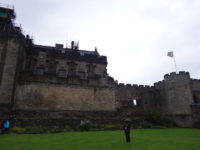 We have had tremendous luck in our years of traveling. In more than a dozen trips to Europe in about twenty years, we have enjoyed good weather and good health. We have had a few hours of rain here and there, but nothing that lasted all day or was problematic. That streak finally came to an end today when I woke up with a sore neck, which induced a headache, which induced an upset stomach. In addition to that, we had an on-again, off-again drizzle all day long, with windy conditions in low-fifties temperatures. We were still grateful that it was not a hard rain all day, but it was the worst weather we have had in our international travels.
We have had tremendous luck in our years of traveling. In more than a dozen trips to Europe in about twenty years, we have enjoyed good weather and good health. We have had a few hours of rain here and there, but nothing that lasted all day or was problematic. That streak finally came to an end today when I woke up with a sore neck, which induced a headache, which induced an upset stomach. In addition to that, we had an on-again, off-again drizzle all day long, with windy conditions in low-fifties temperatures. We were still grateful that it was not a hard rain all day, but it was the worst weather we have had in our international travels.
The headache and other ailments were easier to deal with. I took a couple of Advil and ate as much breakfast as I could stomach (which was not much). Then, Meredith was kind enough to delay the start of the touring day by about an hour and a half to let me go back to bed. That did the trick. I was pretty much back to normal, and away we went.
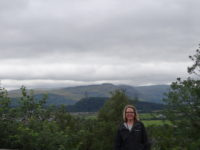 We walked up the main hill in Stirling, all the way to the top, to the castle. Oddly, castles always seem to be built on high ground. It did mean that it had great views of the surrounding area. Stirling’s castle is an important one for Scottish history. It sits at the main river junction between the Highlands to the north and the Lowlands to the south. The castle was home to Scottish monarchs for a couple of hundred years, although the height of the castle was around 1600, right before James VI of Scotland became James I of England. After James moved to London, the castle became less used and eventually became a headquarters and barracks for the army. The army finally moved out in the 1960s, and the castle has been renovated in an attempt to make it look as it might have in the 1500s.
We walked up the main hill in Stirling, all the way to the top, to the castle. Oddly, castles always seem to be built on high ground. It did mean that it had great views of the surrounding area. Stirling’s castle is an important one for Scottish history. It sits at the main river junction between the Highlands to the north and the Lowlands to the south. The castle was home to Scottish monarchs for a couple of hundred years, although the height of the castle was around 1600, right before James VI of Scotland became James I of England. After James moved to London, the castle became less used and eventually became a headquarters and barracks for the army. The army finally moved out in the 1960s, and the castle has been renovated in an attempt to make it look as it might have in the 1500s.
 We got to the castle just a few minutes past 11:00, so we missed the 11:00 tour. We figured we would catch the 11:30 tour, so we wandered into the Queen Anne’s Gardens, which are beautiful and have a magnificent view of the surrounding area and of the main body of the castle itself. We briefly checked out the small museum of the history of the castle, which included a Chutes-and-Ladders-style game that we dubbed “Siege and Ladders.” Sadly, Meredith hit a great ladder and won easily.
We got to the castle just a few minutes past 11:00, so we missed the 11:00 tour. We figured we would catch the 11:30 tour, so we wandered into the Queen Anne’s Gardens, which are beautiful and have a magnificent view of the surrounding area and of the main body of the castle itself. We briefly checked out the small museum of the history of the castle, which included a Chutes-and-Ladders-style game that we dubbed “Siege and Ladders.” Sadly, Meredith hit a great ladder and won easily.
After failing to capture my castle, we made our way to the courtyard to catch the 11:30 tour. The poor tour guide forgot all about it, and so did not show up until about 11:45. He did not make excuses, but just told us he forgot. He was fun and charming, so no harm done. He took us on a forty-five-minute tour, starting at the main gates, which used to be much bigger but were severely damaged by Cromwell’s forces; the gates had been decorative and could not stand up to canon fire. A canon-resistant outer wall was later added.
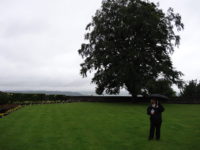 From the inside court, we got a look at the exterior of the main buildings, and he explained what each was – the King’s residence, with 250 statues posted around the outside as display of power and wealth; the Great Hall, restored with golden paint and a new timber roof; the kitchens, where two rooms have been restored to look as they may have done in the 1500s; and the chapel, which James had built for a baptism of his son (and as a display of power and wealth, since he was soon to become King of England).
From the inside court, we got a look at the exterior of the main buildings, and he explained what each was – the King’s residence, with 250 statues posted around the outside as display of power and wealth; the Great Hall, restored with golden paint and a new timber roof; the kitchens, where two rooms have been restored to look as they may have done in the 1500s; and the chapel, which James had built for a baptism of his son (and as a display of power and wealth, since he was soon to become King of England).
The guide took us into the Great Hall, which was the largest secular building in Scotland at the time it was built. The ceiling was a special kind of timber ceiling, designed to be strong and built by ship-builders. The hall can be rented out today for weddings and other special events. Not a bad reception hall.
We finished out tour in the chapel, which was built to be the same proportions as Solomon’s Temple in Jerusalem (but at one third the size, since space was limited in the castle). While there, we saw an advertisement that in a few minutes, the Georgia Boy Choir would be performing, so we stayed.
We were initially not sure if the choir was from Georgia in the US or from Georgia over by Russia. When we saw the program opening with three religious tunes including “Amazing Grace,” we figured it out. The group, made up of boys from seven to seventeen (with three or four alumni as chaperons), sang for about an hour in the magnificent acoustics of the chapel. The were excellent, and I am not always a fan of boys’ choirs. They had three numbers in which they were accompanied by Scottish bagpipes. If you thought the pipes were loud outside, you should hear them inside an enclosed space. Yikes. But the high notes of the youngest boys could still be easily heard. The group did a nice mixture of sacred and secular pieces, and ended with a rousing Scottish song that got people up for a standing ovation. Catching them here was another happy travel coincidence.
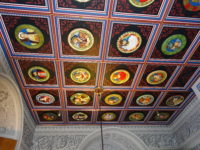 By now it was after 2:00, so we took a much needed lunch break in the castle cafeteria, after which we explored the other buildings on our own for about two hours. We checked out the royal apartments, which have been restored and are highly decorated, including the “Stirling Heads” – wooden carvings of around fifty decorative heads that used to be mounted on the ceiling. The heads were all important people of power – James and his queen, Henry VIII, a few caesars, nobles, etc. The originals are kept in the castle museum, but decorated ones have been remounted in the king’s chamber. We got to see the originals in the museum as well, and most of them are in excellent shape.
By now it was after 2:00, so we took a much needed lunch break in the castle cafeteria, after which we explored the other buildings on our own for about two hours. We checked out the royal apartments, which have been restored and are highly decorated, including the “Stirling Heads” – wooden carvings of around fifty decorative heads that used to be mounted on the ceiling. The heads were all important people of power – James and his queen, Henry VIII, a few caesars, nobles, etc. The originals are kept in the castle museum, but decorated ones have been remounted in the king’s chamber. We got to see the originals in the museum as well, and most of them are in excellent shape.
We looked over the battlements and the ever-shrinking fog-bound view, and then finished up with the kitchens, where we were both surprised to learn that the kitchens were the realm of men and boys – women were not usually allowed in.
Our castle ticket included a tour of the nearby Argyll’s Lodging, the home of a noble that has been restored to what it probably looked like in the 1500s. The house was impressive, but I am still smug and grateful for plumbing and central heating.
That finished off the sites on the hill, so we went back to the B and B to plan our next outing. Meredith wanted to take a two-hour driving tour of nearby landscapes, so we headed out in the misty rain. My biggest issue with driving here is the conditions – the roads are fairly narrow, but the default speed limit is a whopping 60 mph, which people really do drive. It is tense driving, to say the least.
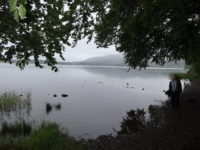 We headed out to see Lake of Menteith (Scotland’s only “lake,” as opposed to lochs). There is even a national park there, so we assumed there would be a vista or welcome center or something. We were wrong. There was one parking lot, with a footpath down to the lake. We kept going, assuming there was somewhere else to see. Not really. After turning around a couple of miles later, we did find a two-car pull-off that had a path down to a very small beach, where we could see the lake and surrounding hills. It was pretty and very quiet; we were still surprised that there was not even a bench or table or the like.
We headed out to see Lake of Menteith (Scotland’s only “lake,” as opposed to lochs). There is even a national park there, so we assumed there would be a vista or welcome center or something. We were wrong. There was one parking lot, with a footpath down to the lake. We kept going, assuming there was somewhere else to see. Not really. After turning around a couple of miles later, we did find a two-car pull-off that had a path down to a very small beach, where we could see the lake and surrounding hills. It was pretty and very quiet; we were still surprised that there was not even a bench or table or the like.
We continued on to the town of Aberfoyle, which is a gateway into the Highlands. I had no idea that the Highlands started so dramatically – they just loom over the town. In one spot, you are in the Lowlands, and just a few yards away are the Highlands, with very little transition. We turned there and headed back to Stirling, to the B and B and then back downtown for supper.
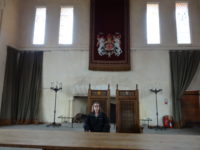 So, headache and rain happened, but we still got a successful day of touring in, with a choir surprise as well. Bonny.
So, headache and rain happened, but we still got a successful day of touring in, with a choir surprise as well. Bonny.
Raining? In Scotland? What a shock. (Sorry/notsorry about your headache.)
It was not surprising, but we had been three times to Ireland for a total of six weeks with very little rain. We have had very good luck. Even now, it looks like we might only have two days of all-day rain here – not bad.